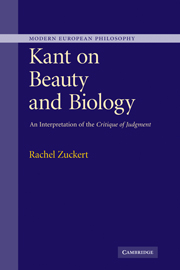2 - Reflective judgment and its principle: Preliminary remarks
Published online by Cambridge University Press: 22 September 2009
Summary
In the CJ introductions, Kant not only raises the epistemological concerns discussed in the previous chapter, but also claims that they are to be addressed by reflective judging in accord with its own a priori principle – and that aesthetic judgment and teleological judgment are “exhibitions” of such judging. In the following chapters, I shall interpret these claims to mean that in all of these forms of judging, the subject represents objects (or sets of objects) as unities of diversity as such – and does so by judging in accord with the principle of purposiveness without a purpose. This principle is not, moreover, to be understood as a mere assumption that objects satisfy some cognitive requirement, and/or that if they do so, contingently, they are “as if” made to be so. Rather, it is a form of relations that holds among diverse, contingent, sensibly given items, rendering them (as such) lawfully, non-arbitrarily unified – and that structures the judgmental activity of so representing them. Before turning to more detailed arguments for these interpretive claims, however, I shall in this chapter (preliminarily) present my general strategy, and defend it against interpretive questions that might be raised and common global objections to Kant's claims.
Reflective, aesthetic, and teleological judging: The questions
As we have seen, Kant's questions concerning the possibility and justifiability of empirical cognition may be understood to concern the activity of reflective judging, our ability to “find” universals for particulars (whether unconceptualized sensible particulars, or particulars conceived according to lower concepts or laws, for which the subject attempts to formulate higher laws).
- Type
- Chapter
- Information
- Kant on Beauty and BiologyAn Interpretation of the 'Critique of Judgment', pp. 64 - 86Publisher: Cambridge University PressPrint publication year: 2007

